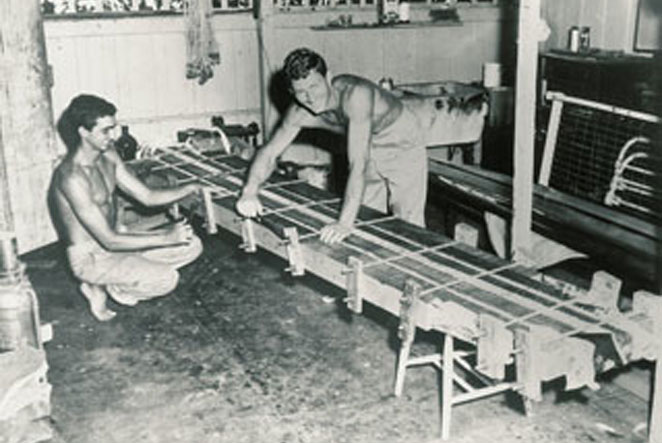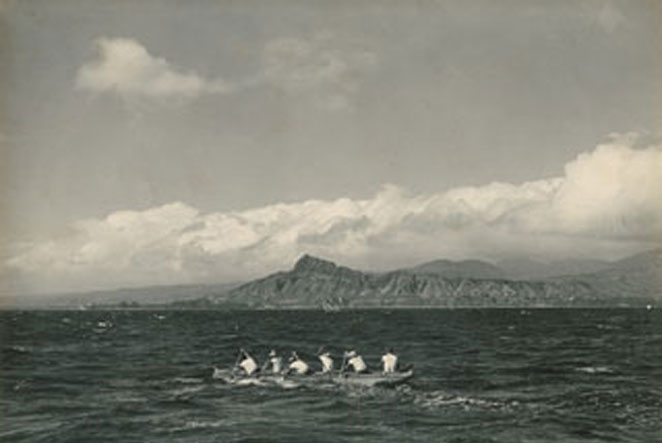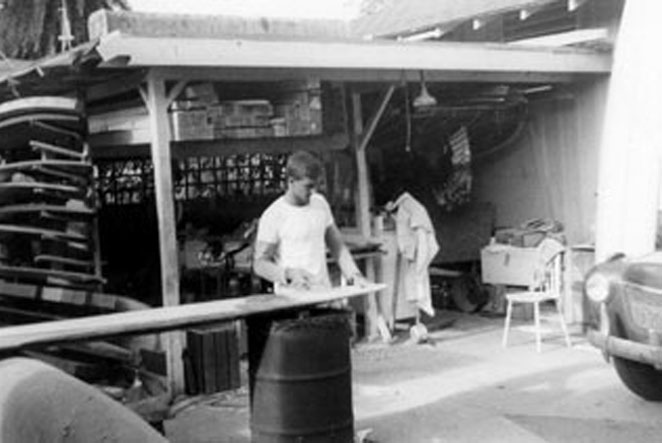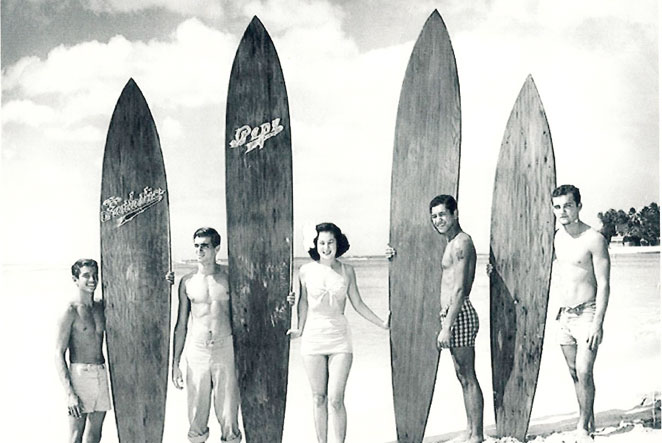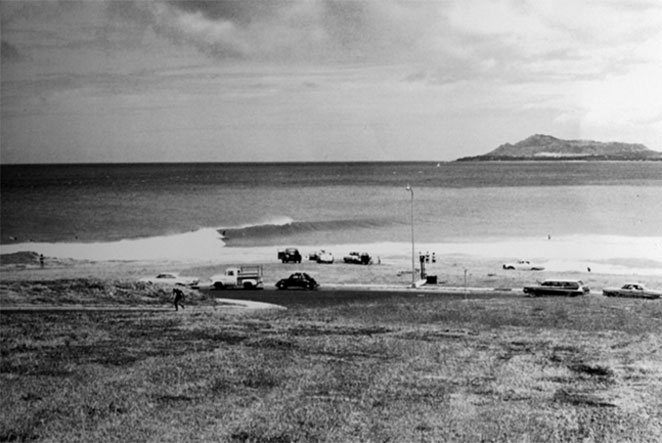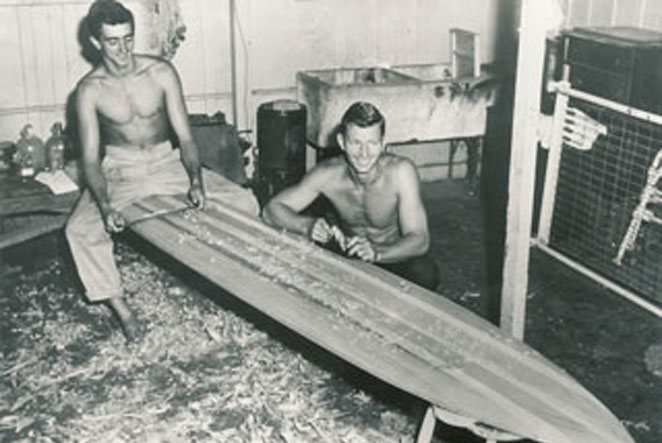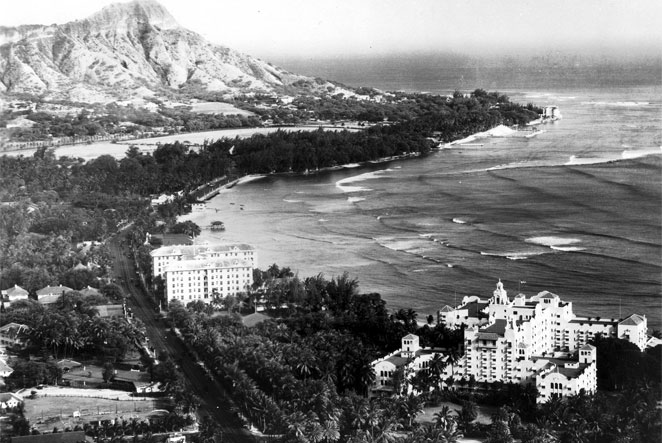The Downing Ohana and their history is a part of modern Hawaiian surfing. George Downing is one of the major figures, both in a historical and contemporary sense, who has served as ombudsman for the Hawaiian surf athlete while exerting his own street smarts and personal credibility to oppose the abuse of their natural waters. Along his life path, George has gained a unique knowledge of surfboards, paddleboards, outrigger canoes, of testing our limits in big-waves, and of the nature of people in general, which he shares selectively. He has traveled as a protector/advisor to U.S. and Hawaiian teams in World competitions, an assignment requiring all his wile and guile. He has formulated and introduced creative-format surfing competitions into being, influenced surfboard design, served as a lifesaver for numerous individuals who have come to him for help, acted as mentor to the sport and its industry as a whole, and to Captains within it’s core, all without compromising his sense of balance.
Born in 1930, George began surfing on a solid redwood plank at Waikiki in the mid-1940s. A year or so later, his beach boy ukulele instructor recognized his lack of enthusiasm for afternoon lessons under the Hau tree and released him to the surf where he had already exhibited a predilection to excel. While working as a beachboy during and after the war, George encountered visitors from all walks of life, some of whom became enamored of the handsome and graceful young instructor, noting a potential for success at whatever wave he might choose. They bestowed on him advice in the ways of a world beyond the beach. In the later 1940s, George became the youngest member of a group of watermen that included Fran Heath, Wally Froiseth, John Kelly, with ex-gilder pilot distance record holder Woody Brown contributing aerodynamic ideas to their increasingly foiled surfboard shapes. It was Kelly and Heath who had discovered the revolutionary hot curl design by suddenly and impulsively narrowing the aft of one of their wide-tailed redwood planks with a hatchet! When Kelly and Heath chopped the tail into a drawn-in shape and slightly vee’d the bottom, it suddenly caused the board to hold to the wave on an angle. This allowed them to traverse while staying in the green, rather than riding soup towards the beach, which profoundly changed surfing. That clan of surfers, of whom George was then the young hot-rod member, adapted that theory to their 10-11’ craft and began exploring big waves around the island—waves that had previously had been thought un-rideable. Makaha came into play after Kelly camped there on a dive trip and returned home raving about the surf. Makaha Point waves became the new frontier and George an eager explorer. The Hawaiian’s hot curl plan shapes became the basis for the modern big wave surfboard. Primary architects and test pilots were George, Wally Froiseth, and their elder guru Woody Brown, Always an experimenter, George and his decade older mentor Wally Froiseth played together with surfboard design. One would swim at Makaha out wearing a mask to hang underwater and watch the other ride by, observing the water flow off the bottom, then they’d go in, revise the board right there on the beach and try it again.
Through the late 1940s, George rode his beloved redwood plank “Pepe” at Makaha. It was a heavy, fast-tracking hot curl that he and Wally had shaped out of an already aged “plank” belonging to a beach boy named ”Brownie” who had awarded it to young Georgie, sensing he had a future. In 1948, George, Wally and Russ Takaki crewed a Transpac sailboat back to California where they bought a Model A for $25 and toured from Tijuana Sloughs and WindandSea, to Malibu. After ramming Pepe into a Malibu pier piling, George was introduced to fiberglass by Bob Simmons as a new repair material. In 1951, George would build an experimental, all balsa, pintail named “The Rocket” that featured the first moveable fin: a redwood fin box with a wooden fin that he could wedge in, try, then take out and move fore or aft and retest. Using trial and error he determined the correct setting and glassed it into a permanent position. George would later explain that the use of fiberglass made an even bigger contribution when used for attaching fins which spread the load of the fin torque across a greater bottom area, allowing for deeper fins thus modern maneuvering, versus use as a waterproof coating for light but absorbent balsawood. In 1954, the Makaha International Surfing Championship begun which would be the first major surfing event in the sport’s modern history. George was the first Men’s Champion and then the first repeat winner in years 1961 and 1965. He traveled to Peru in 1955 as a surfing emissary, winning their Championship and establishing life-long relationships with hard-playing, wealthy Peruvian surfers. In all facets of his life in the ocean: paddleboard racing, canoe paddling and surfing, surfing big waves and small, instructing, renting surfboards, sailing and diving, George has always been known as calculating, thoughtful, and strategic in studying and understanding the forces he is dealing with before coming up with a tactic to win with. This knowledge he’s passed down to his children and now grandchildren. In addition to his unique big wave-riding prowess, all through the war and post-war period, George won the Diamond Head paddleboard races, becoming a standard bearer for that skill, and the fastest paddleboard racer in all distance categories who, currently in his early 80s, still happens to hold the record for the 100-yard sprint.
As a teenager, George worked as a deck hand taking tourists for rides on Woody Brown’s first catamaran Manu Kai, co-designed and built with Alfred Kumalae. In 1960, George took over the operation of the Waikiki Beach Center, serving the tourist hordes that swarmed the sand and surf of Waikiki with rentals and lessons. All through those years he continued to tap standout swells at Sunset, Laniakea, Makaha, and at the traditional Waikiki big wave break far outside the Natatorium, Castle Surf.
His daughter Kaiulu, and sons Keone and Kainoa are all accomplished water athletes in canoe paddling and surfing, all three have raced canoes for the Outrigger Canoe Club, all have won the Molokai to Oahu canoe race considered the World Championships of open ocean racing with the boys winning five times, a three-man canoe surfing competition held in big Castles surf, Kainoa was finalist in the Pipe Masters, and Keone having been ranked as high as fifth in the world at 16 years of age competed in the World Amateur Championships and on the World Professional Tour. In 1990 Keone won the Quiksilver in memory of Eddie Aikau Big Wave Invitational in 25 to 35 foot surf at Waimea Bay.
A graduate of California College of the Arts, Keone runs the family ocean sports store, Downing Hawaii, on Waialae Avenue in Kaimuki, where he shapes, designs graphics and merchandises the store with water wear and hardcore gear with his sister, while, from the tiny office in the back, George (tagged “The Governor” by Keone) conducts an ongoing matrix of behind-the-scenes campaigns to preserve Hawaii’s most treasured beaches, reefs, and surf breaks which are constantly targeted for “improvements” that would degrade them. Additionally, George is the self appointed protector of those special friends who, being kind souls, are vulnerable to land sharks thus come under his relentless umbrella.
Downing created the format for the Quiksilver in Memory of Eddie Aikau at Waimea Bay, showcasing the rebirth of big wave riding and offering the biggest winner’s check in surfing history. The unique event protocol of not being held in less than 20’ conditions causes it to happen with unpredictable frequency, which lends each actual competition added gravitas. George has steered The Eddie through the normal entanglements which he has as skillfully navigated as he once did the channel at Laniakea, knowing that the rip current there runs out underneath the incoming waves, thus you must not dive down, stay in the white water to get in. At least several times each season George makes the on-or-off call that itself causes ripples around the world. From November through February, he remains focused on the swell buoys. On mornings pregnant with possibility, he and his pickup truck can be found in the gray of first light, overlooking the Bay, with George keenly confirming his diagnosis so as to make the early call that is necessary either way. The event that George has nurtured for over two-and-a-half decades has helped reestablish the preeminence of riding big waving within the surfing culture.

